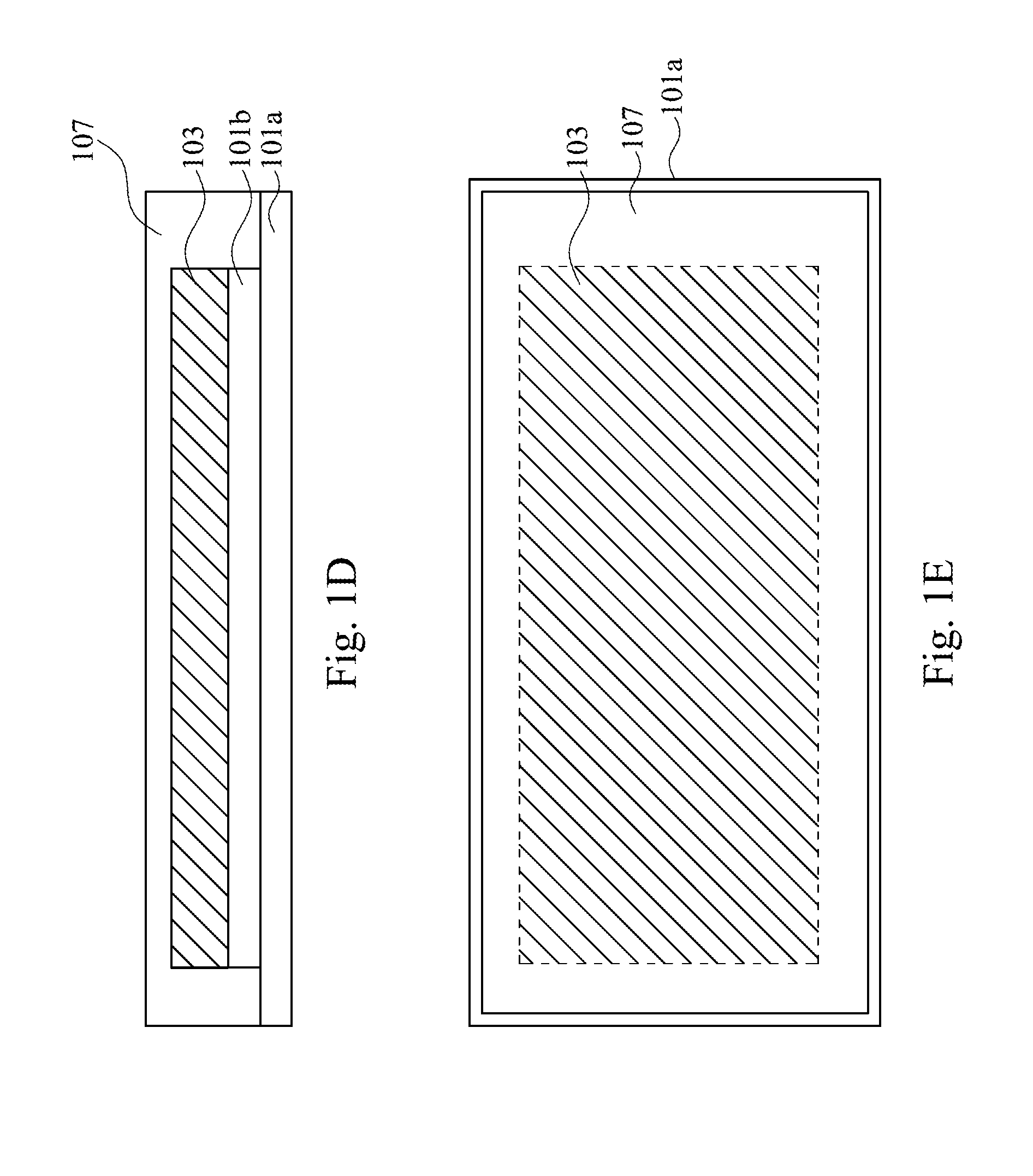Structure and method for packaging organic photoelectric device
a photoelectric device and organic technology, applied in thermoelectric devices, basic electric elements, final product manufacturing, etc., can solve the problems of poor moisture blocking ability of organic flexible substrates, the moisture permeation of organic semiconductor materials and the moisture permeation resistance of flexible devices is still a serious problem to be overcom
- Summary
- Abstract
- Description
- Claims
- Application Information
AI Technical Summary
Benefits of technology
Problems solved by technology
Method used
Image
Examples
first embodiment
[0026]FIG. 1E is a top view of the structure for packaging the organic photoelectric device during the manufacturing process according to the present disclosure. As shown in the top view, a cross-sectional area of the permeation barrier layer 107 is greater than the cross-sectional area of the organic photoelectric device 103 but is substantially equal to the cross-sectional area of the inorganic substrate 101a. Thus, the entire organic photoelectric device 103 is covered with the permeation barrier layer 107 and is prevented from being damaged by the moisture.
second embodiment
[0027]FIG. 2A to FIG. 2C are diagrams of a structure for packaging the organic photoelectric device during a Roll-to-Roll manufacture process according to the present disclosure. A Roll-to-roll process is highly efficient and can perform the production continuously, it is generally applied on flexible material, such as films, plastics, or stainless steel sheets. In addition, metal substrates which are thin enough (thickness of about 203 is unwound from the roller 201, organic photoelectric devices 205 are set on the substrate 203. In the Roll-to-Roll process, the manufacturing of the organic photoelectric devices 205 depends on the materials and kinds of processes. The Roll-to-Roll process is substantially applied on the patterning lithography steps such as the coating step, photo-resister disposing step, exposure step, etching step, and the photo-resister removing step, to produce the organic photoelectric devices.
[0028]Then, a laser ablation process is performed for patterning in ...
third embodiment
[0031]FIG. 3A to FIG. 3E are cross-sectional structure diagrams of an organic photoelectric device during a manufacturing process according to the present disclosure. In the manufacturing of the organic photoelectric devices, a metal layer 301, a semiconductor layer 303, a dielectric layer 305, a gate layer 307, and an intermediate layer 309 are sequentially stacked on a hybrid substrate 101. In other words, the semiconductor layer 303 is disposed on the metal layer 301; the dielectric layer 305 is disposed on the semiconductor layer 303; the gate layer 307 is disposed on the dielectric layer 305; and the intermediate layer 309 is disposed on the gate layer 307. Particularly, the intermediate layer 309 covers each layer of the organic photoelectric device and contacts with the hybrid substrate 101.
[0032]FIG. 4A to FIG. 4C are current-voltage curve diagram of the organic photoelectric devices. FIG. 4A presents the current-voltage curve of the organic photoelectric device without the ...
PUM
 Login to View More
Login to View More Abstract
Description
Claims
Application Information
 Login to View More
Login to View More - R&D
- Intellectual Property
- Life Sciences
- Materials
- Tech Scout
- Unparalleled Data Quality
- Higher Quality Content
- 60% Fewer Hallucinations
Browse by: Latest US Patents, China's latest patents, Technical Efficacy Thesaurus, Application Domain, Technology Topic, Popular Technical Reports.
© 2025 PatSnap. All rights reserved.Legal|Privacy policy|Modern Slavery Act Transparency Statement|Sitemap|About US| Contact US: help@patsnap.com



